Introduction to the Supreme Court of Mexico (SCJN)
The Supreme Court of Mexico (SCJN) has presented its new institutional image, featuring a redesigned logo that incorporates the bastón de mando, a symbol representing indigenous peoples, to reflect diversity, inclusion, and proximity to society.
Bastón de Mando: Central Symbol
The bastón de mando, a cultural and spiritual element of indigenous peoples, is now integrated as the new institutional symbol, acknowledging legitimate authority and the duty to serve justly.

The Supreme Court of Mexico renovated its visual identity with a logo that incorporates the bastón de mando, symbol of indigenous peoples, to reflect plurality.
Inclusive and Approachable Justice
The SCJN explained that the new institutional image reflects Mexico’s pluricultural nature and aims to integrate historically excluded sectors. It also highlighted the commitment to environmental protection, human rights defense, and attention to vulnerable groups.
Key Questions and Answers
- What is the Supreme Court of Mexico (SCJN)? The SCJN is the highest court in Mexico, responsible for interpreting the Constitution and ensuring that laws comply with it.
- Why did the SCJN update its institutional image? The SCJN updated its image to reflect Mexico’s cultural diversity, include historically excluded groups, and emphasize its commitment to human rights, environmental protection, and support for vulnerable populations.
- What is the significance of the bastón de mando in the new logo? The bastón de mando, a symbol of indigenous peoples’ authority and spirituality, represents the SCJN’s commitment to inclusivity, respect for cultural diversity, and proximity to society.
- How does the new image represent the SCJN’s role in society? The updated logo signifies that the SCJN is a “Constitutional Tribunal serving society,” emphasizing accessible, credible, and people-oriented justice.






